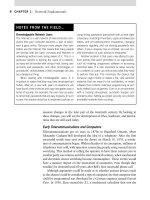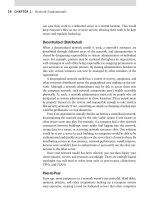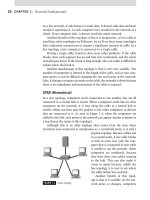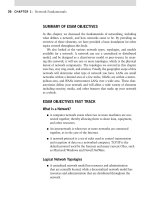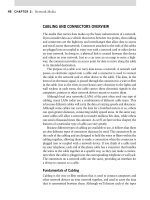CompTIA Network+ Certification Study Guide part 40 ppt
Bạn đang xem bản rút gọn của tài liệu. Xem và tải ngay bản đầy đủ của tài liệu tại đây (105.47 KB, 10 trang )
376 CHAPTER 8: Wide Area Networking
What is the biggest difference between packet-switched and circuit-Q:
switched networks?
The biggest difference between packet-switched and circuit-A:
switched networks is that circuit switching requires someone
to configure and set up each individual connection before it is
used, where as packet switching allows for dynamic setup and an
always-on connection.
Why is packet-switching technology so much more desirable?Q:
Packet switching is more desirable than circuit switching because A:
packet switching divides the transmitting data into packets and
given sequence numbers so that they can all be put back together
again in the right order at the destination. The benefit of this is
that each packet can take a different route to get to its destination.
Once there, the message will be recompiled and take its original
form. Circuit switching does not allow for this kind of flexibility
because it is not an always-on switching method.
Should I memorize the speeds of WAN protocols for the test?Q:
Understanding the different kinds of WAN protocols and proper-A:
ties, how they differ and why is vital to answering the CompTIA
Network+ exam question correctly. There will be plenty of
questions on the exam that are scenario-based in which you have
to know the speeds of various WAN protocols and properties.
Is Frame Relay more flexible compared to FDDI?Q:
Frame Relay is more flexible than FDDI because if an organization A:
needs to communicate to their remote sites, they can add or take
away channels as needed depending on how much bandwidth is
required. With FDDI, the idea is to provide high-speed service to all
stations connected to the ring. If you no longer need such services
at one remote site, you cannot change the fixed bandwidth without
affecting all sites.
What kind of organizations use Optical Carrier (OCx) links?Q:
The SONET standard defines a hierarchy of interface rates that A:
allow data streams at different rates to be multiplexed (as shown
in Table 8.1). SONET establishes OCx levels from 51.8 Mbps to
40 Gbps. OCs are usually implemented for large organizations like
ISPs to transmit huge amounts of network traffic while allowing
for types of data like voice and video to be sent and received around
the world in seconds.
Self Test 377
What is the difference between ADSL and SDSL?Q:
The difference between ADSL and SDSL is that homes and small A:
businesses use ADSL whereas larger companies use SDSL due
to the increased upstream and downstream data speeds. SDSL
operates at approximately 2 to 2.5 Mbps both downstream and
upstream. ADSL generates downstream speeds of approximately
8 Mbps and upstream speeds of up to 640 Kbps.
Is ISDN the same thing as dial-up?Q:
Both use dialing, but dial-up is based on the telephone system and A:
uses analog lines, whereas ISDN (and DSL) are both digital. For the
Network+ exam, you need to have a clear picture of each technology
and its basics, and you must be able to differentiate between them.
What is the main difference between a satellite and WWANs?Q:
The main difference is that satellites use low, medium, and geosyn-A:
chronous Earth orbit satellites in space to transfer data; whereas
WWANs use antennas on Earth, not in space, to transfer data.
SELF TEST
As the primary lead on your company’s helpdesk, you are asked to 1.
help resolve a problem call with an ISDN line. A customer wants to
upgrade an existing ISDN line because it’s currently too slow. Right
now, he is using a single BRI ISDN circuit-switched B channel.
From the available choices, what should his transmission rate be?
A. 56 Mbps
B. 64 Kbps
C. 128 Kbps
D. 256 Mbps
As the network administrator for your company, you are asked by 2.
your CIO to design and deploy a data link between two offices of
your company. There are 10 employees located in each office. Your
main concerns are the speed of the connections, the reliability
of transferring of data, and the cost. Which solution should you
implement? (Choose one)
A. Place a modem on a server in each office so they can connect.
B. Connect an ISDN circuit to each workstation in both locations.
378 CHAPTER 8: Wide Area Networking
C. Use an ISDN circuit connected to a dedicated location or server
in each building.
D. Have each workstation at both locations use a modem to
connect to opposite offices.
You are the IT manager for rsnetworks.net. As the person respon-3.
sible for recommending the right technology, what would you select
as the solution to provide the fastest connectivity? (Select one)
A. T3
B. T1
C. ISDN BRI
D. Cable modem
You want to connect a remote office to a corporate network. The 4.
only available service is an analog dial-up line provided by the local
telephone company. What device would you need to implement to
use this analog dial-up solution?
A. CSU/DSU
B. ISDN adapter
C. Modem
D. NIC
As the Network Manager for rsnetworks.net, you need to imple-5.
ment a solution that will allow for sporadic connection to the
Internet. Your only requirement is that you find a solution that will
provide a connection of up to 128 Kbps to the Internet, only when
needed. Which solution should you implement?
A. T1
B. T3
C. 56 Kbps
D. BRI ISDN
As a network manager for your company’s high-speed network, you 6.
are looking to implement a new line from a remote site (Chicago)
to the company’s core hub (New York) where the mainframe is
located. The mainframe is where all the company’s sales orders
are placed daily. The hub site is where all sites get their Internet
access from, and where they upload and download files to and
from. Connection to this mainframe 24 hours a day is essential to
meeting the business plan. You have just heard from your systems
Self Test 379
engineer that users are no longer able to access the mainframe from
the remote sites; the users at the core site are still able to access the
mainframe.
Within minutes, the connection is restored and all users are
able to access the mainframe once more. From careful analysis, you
uncover that during the time that the remote users were not able to
access the mainframe, one user had been downloading a very large
file from the Internet to the remote site user’s PC. You find that
the user was downloading a legitimate file and will be doing so each
day. You cannot afford this type of network slowdown each day, so
you decide to allow for the upgrading of the line. It’s currently at
128 Kbps using ISDN BRI. You have found that after careful analy-
sis of the remote sites’ usage patterns and looking over the docu-
mentation of the current network, an upgrade of approximately
1.5 Mbps is needed across all links. Which technology would you
implement? (Choose one)
A. ADSL
B. E1
C. LAN adapter
D. T1
The PSTN is the analog-based telephone system we have come 7.
to be very familiar with today. What are some of the features of
PSTN? (Choose all that apply)
A. Compared to DSL and ISDN, it is inexpensive
B. Worldwide installation base in use and readily available
C. Easy to use and configure
D. Transfer rates of 64 Kbps
You are a network administrator at your company. Your company 8.
has a number of sales and marketing users who work remotely and
telecommute from home or from sales meetings. These users dial
into a remote access service (RAS) server to access the corporate
headquarters. One day, one of the sales users dials up the RAS
server to connect to the corporate headquarters network to access a
few files. The sales user dials up the RAS server and cannot con-
nect. The sales user reports that there is no dial tone. What is the
cause of the problem? (Choose one)
A. Telephone company problem.
B. The modem does not support the PC.
380
CHAPTER 8: Wide Area Networking
C. The modem settings are set incorrectly.
D. There are no settings configured within Windows.
You are the network technician at your company. You are configur-9.
ing a Windows NT 4.0 laptop for dial-up networking. The laptop
will be used by a telecommuter. The telecommuter will use the
laptop to dial into a Microsoft Windows NT 4.0 RAS server. Once
connected, the telecommuter will need access to a UNIX machine.
What should you install on the laptop? (Choose two)
A. TCP/IP Protocol
B. RDP
C. VPN
D. Dial-up networking
You are a consultant looking over network documentation for a 10.
small company with one core site and two remote sites. Router A
shows the location of the corporate headquarters where there is also
a link out for Internet access and another remote site configured to
also connect to the core. From Figure 8.8, what type of WAN tech-
nology is in use based on the information shown for Link A?
A. DSL
B. T3
C. T1
D. FDDI
FIGURE 8.8 WAN Technology.
Router A
Corporate HQ
Link A Speed � 1.544 Mbps
Link A
Router B
Remote Site
Link B
Router C
Remote Site
Self Test 381
You are the network manager and you just sat down for lunch at your 11.
desk. You notice that you have to troubleshoot a circuit-switching
network from a note written by your boss. Your boss has also placed
a picture of this circuit-switched network on your desk. What is the
usual WAN technology associated with circuit-switched networks?
A. Internet Services Digital Network
B. Integrated Services Digital Netware
C. Integrated Services Diagram Network
D. Integrated Services Digital Network
What is the difference between ISDN and dial-up?12.
A. Both use dialing, but dial-up is based on the WAN and uses ana-
log lines, whereas ISDN (and DSL) are both digital.
B. Neither use dialing, but dial-up is based on the telephone system
and uses analog lines, whereas ISDN (and DSL) are both analog.
C. Both use dialing, but dial-up is based on the telephone system
and uses digital lines, whereas ISDN (and DSL) are both digital.
D. Both use dialing, but dial-up is based on the telephone system
and uses analog lines, whereas ISDN (and DSL) are both digital.
You just got hired on to a Mobile Telecommunication Cellular 13.
company and your first assignment is to teach your junior network
engineers what WIMAX is. What description best describes what
WIMAX is and stands for?
A. WIMAX stands for WWW Interoperability for Microwave Access.
It is based on IEEE 802.16 standards, or Broadband Wireless
Access. An acceptable rule of thumb is that WIMAX will sustain
70 Mbps transmission rates at approximately 15 miles.
B. WIMAX stands for Worldwide Interoperability for Microwave
Access. It is based on IEEE 802.11 standards, or Broadband Wire-
less Access. An acceptable rule of thumb is that WIMAX will
sustain 70 Mbps transmission rates at approximately 30 miles.
C. WIMAX stands for Worldwide Internet for Microwave Access.
It is based on IEEE 802.16 standards, or Broadband Wireless
Access. An acceptable rule of thumb is that WIMAX will sustain
70 Mbps transmission rates at approximately 15 miles.
D. WMAX stands for Worldwide Interoperability for Microwave
Access. It is based on IEEE 802.16 standards, or Broadband Wire-
less Access. An acceptable rule of thumb is that WIMAX will
sustain 70 Mbps transmission rates at approximately 30 miles.
382 CHAPTER 8: Wide Area Networking
FIGURE 8.9
What is Figure 8.9 depicting? Choose the best answer.14.
A. WIMAX similar network
B. Satellite-based network
C. Wireless Wide Area Network
D. Wide Area Network technology
15. How far do LEOs and MEOs orbit above the earth?
A. LEOs 1,800 to 2,000 miles; MEOs 1,800 to 2,000 miles
B. LEOs 1,800 to 2,000 miles; MEOs 2,000 to 10,000 miles
C. LEOs 1,800 to 2,000 miles; MEOs 9,000 to 10,000 miles
D. LEOs 9,000 to 10,000 miles; MEOs 9,000 to 10,000 miles
Self Test Quick Answer Key 383
SELF TEST QUICK ANSWER KEY
C1.
C2.
A3.
C4.
D5.
D6.
A, B, and C7.
A8.
A and D9.
C10.
D11.
D12.
D13.
B and D14.
C15.
This page intentionally left blank
385
CHAPTER 9
Security Standards and Services
EXAM OBJECTIVES IN THIS CHAPTER
HARDWARE AND SOFTWARE SECURITY DEVICES 386
SECURITY ZONES 405
NETWORK PORTS, SERVICES, AND THREATS 416
NETWORK ACCESS SECURITY 431
INTRODUCTION
In today’s network infrastructures, it is critical to know the fundamentals
of basic security infrastructure. Before any computer is connected to the
Internet, planning must occur to make sure that the network is designed in
a secure manner. Many of the attacks that hackers use are successful because
of an insecure network design. That is why it is so important for a security
professional to use secure topologies and tools like intrusion detection and
prevention to help thwart attacks.
Another security mechanism that may be deployed is a virtual local area
networks (VLANs). VLANs are responsible for securing a broadcast domain
to a group of switch ports. This relates directly to secure topologies because
VLANs allow for different Internet Protocol (IP) subnets to be configured in
different port groupings and separated, either by routing or by applying an
access control list (ACL). This allows for separation of network traffic; for
example, the Executive group can be isolated from the general user popula-
tion on a network, which can aid in securing the infrastructure.
Test Day Tip
An ACL is a list of users that have permission to access a resource or modify a file.
ACLs are used in nearly all modern-day operating systems (OSs) to determine what
permissions a user has on a particular resource or file.



